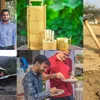Materials, messages, meaning: how this artist reminds us of environmental sustainability
In our third photo essay on the Kiran Nadar Museum of Art, we showcase the works and insights of Jayashree Chakravarty.
Launched in 2014, PhotoSparks is a weekly feature from YourStory, with photographs that celebrate the spirit of creativity and innovation. In the earlier 485 posts, we featured an art festival, cartoon gallery. world music festival, telecom expo, millets fair, climate change expo, wildlife conference, startup festival, Diwali rangoli, and jazz festival.

The Kiran Nadar Museum of Art (KNMA) celebrates its tenth anniversary this year. See our earlier interviews with Kiran Nadar, Founder and Chairperson, KNMA, and Roobina Karode, Chief Curator.
Based in New Delhi, KNMA hosted four exhibitions earlier this year, titled Scripting Time, Memory, and Ecology (curated by Roobina Karodem); Zarina: A Life in Nine Lines; Line, Beats and Shadows; and Abstracting Nature. The inter-generational themes spanned history, politics, spirituality, and the environment.
The featured works in this article series are by Zarina Hashmi, Ayesha Sultana, Prabhavathi Meppayil, Lala Rukh, Sumakshi Singh, Mrinalini Mukherjee, and Jayashree Chakravarty. Works of some of the artists have also been exhibited at the Kochi-Muziris Biennale (see our six-part coverage of the 2019 edition here).
In this photo essay, we feature the artworks and insights of Jayashree Chakravarty. She was born in Tripura and studied at Santiniketan and MS University in Baroda. Her art is influenced by her years in Kolkata. Her paintings and installations reflect experimentation with a range of materials, including paper, fabric, cellophane, leaves, and dry flowers.
(Note: These photographs from the gallery were taken before the national lockdown due to the coronavirus. The visit to the gallery was not in violation of any public safety guidelines.)
“To me, art means to be able to see more meaningfully, observe deeply, focus on a few elements, and unveil the depths of what we are seeing,” Jayashree Chakravarty explains, in a chat with YourStory.
“Art means to be able to convey our experiences as well as our fantasies. It is a desire to deliver our inner message. I feel it is a journey and a dialogue with our inner soul,” she adds.
She has been making works with paper for a while now, using multiple thin translucent layers, pasted on cotton fabric. “This creates a leather-like strong surface. My works are mostly scroll-like and are often displayed by suspending them from the ceiling,” she explains.
Jayashree spent her early days in Tripura, surrounded by nature. “So in my work, I talk about naturally-growing plants, insects, and vegetation, which are lost from the environment these days. We need natural space to spend some restful time,” she emphasises.
To be successful as an artist, internal exploration is very important. “Through each work, we learn a little more each time. Artists often find a way to go into deeper areas of their creative fields while making their works,” Jayashree says. This kind of focus brings in a great feeling of contentment.
“Awards and appreciation certainly give confidence, although commercial success is something very different. Not all artists aim for or get this kind of success. However, financial support is also necessary for continuing individual artistic practices,” she clarifies.
She calls for more art appreciation and awareness in India. “To enable the audience to reach better standards of art appreciation, they need to be exposed to viewing art at a very early age, from school level,” Jayashree advises.
More videos, documentaries, or short films can be broadcasted on television to give better art exposure to a larger audience. “More museums should be there, both private as well as government. A lot more initiative can be taken up by the government in the field of visual arts to increase awareness,” she adds.
At KNMA, Jayashree exhibited her works titled Earth as Haven under the Canopy of Love. It was originally a site-specific work for Musée Guimet Paris. “It was very exciting for me to install the work in a new space,” she enthuses.
The effect of the suspended structure in a scroll-layered forest-like space comes across an imaginary insect-like form in the middle of the natural environment. “This insect is a cave-like form where people can walk in. With a torch or mobile light, one can see the inside views, where I have created an intricate and shimmery insect world,” Jayashree explains.
There is also a vitrine or glass case, where she has put all the organic and natural material used in the work. “I have also created a few large drawings for this show, which have been displayed in another room in the exhibition space,” she adds.
Jayashree’s other works are also about the shrinkage of natural space, disappearing flora and fauna in the environment, and reducing water bodies. “I have been creating work concerning ecological balance. My current practice is a continuous extension of these longstanding concerns,” she explains.
The prices for her artworks are decided by the Akar Prakar Gallery in Kolkata. Prices depend on various measures, from the size of the work to the kind of creative and methodical engagement that has gone into it.
Jayashree found the experience of exhibiting at KNMA to be absolutely encouraging and wonderfully inclusive. “I am also very glad to learn about the positive feedback from the audience,” she proudly says.
She urges audiences to view more artworks so as to understand and acquire a taste for the visual arts. “A lot of interaction and reading would be helpful to develop this kind of affinity towards visual arts,” she advises audiences.
“One has to dedicate time to study a visual language,” she adds. “I would advise aspiring artists to learn and practise art sincerely with full dedication,” Jayashree signs off.
Now, what have you done today to pause in your busy schedule and find meaningful connections to your creative core?






















Jayashree Chakravarty
See also the YourStory pocketbook ‘Proverbs and Quotes for Entrepreneurs: A World of Inspiration for Startups,’ accessible as apps for Apple and Android devices.
(Edited by Teja Lele Desai)









